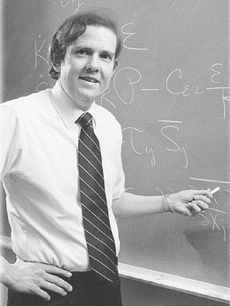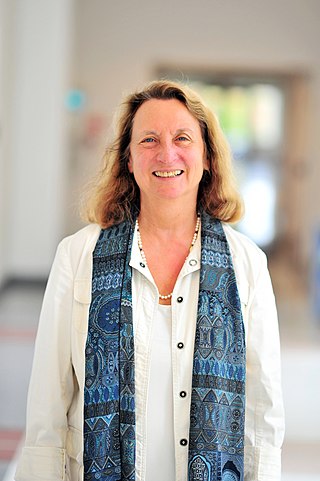Related Research Articles

New Jersey Institute of Technology (NJIT) is a public research university in Newark, New Jersey, with a graduate-degree-granting satellite campus in Jersey City. Founded in 1881 with the support of local industrialists and inventors especially Edward Weston, NJIT opened as 'Newark Technical School' ('NTS') in 1885 with 88 students. As of fall 2022 the university enrolls 12,332 students from 92 countries, about 2,500 of whom live on its main campus in Newark's University Heights district.

Howard Alvin Stone is the Neil A. Omenn '68 University Professor in Mechanical and Aerospace Engineering at Princeton University. His field of research is in fluid mechanics, chemical engineering and complex fluids. He became an Editor of the Annual Review of Fluid Mechanics in 2021.

Chia-Chiao Lin was a Chinese-born American applied mathematician and Institute Professor at the Massachusetts Institute of Technology.
Howard Wilson Emmons (1912–1998) was an American professor in the department of Mechanical Engineering at Harvard University. During his career he conducted original research on fluid mechanics, combustion and fire safety. Today he is most widely known for his pioneering work in the field of fire safety engineering. He has been called "the father of modern fire science" for his contribution to the understanding of flame propagation and fire dynamics. He also helped design the first supersonic wind tunnel, identified a signature of the transition to turbulence in boundary layer flows, and was the first to observe compressor stall in a gas turbine compressor. He initiated studies on diffusion flames inside a boundary layer, and Emmons problem is named after him. He was eventually awarded the Timoshenko Medal by the American Society of Mechanical Engineers and the 1968 Sir Alfred Egerton Gold Medal from The Combustion Institute.

Katepalli Raju Sreenivasan is an aerospace scientist, fluid dynamicist, and applied physicist whose research includes physics and applied mathematics. He studies turbulence, nonlinear and statistical physics, astrophysical fluid mechanics, and cryogenic helium. He was the dean of engineering and executive vice provost for science and technology of New York University. Sreenivasan is also the Eugene Kleiner Professor for Innovation in Mechanical Engineering at New York University Tandon School of Engineering and a professor of physics and mathematics professor at the New York University Graduate School of Arts and Science and Courant Institute of Mathematical Sciences.
Mohammed Yousuff Hussaini is an Indian born American applied mathematician. He is the Sir James Lighthill Professor of Mathematics and Computational Science & Engineering at the Florida State University, United States. Hussaini is also the holder of the TMC Eminent Scholar Chair in High Performance Computing at FSU. He is widely known for his research in scientific computation, particularly in the field of computational fluid dynamics (CFD) and Control and optimization. Hussaini co-authored the popular book Spectral Methods in Fluid Dynamics with Claudio Canuto, Alfio Quarteroni, and Thomas Zang. He is the editor-in-chief of the journal Theoretical and Computational Fluid Dynamics.

Charles Gregory Speziale was an American scientist who had worked in NASA Langley Research Center and a former Professor in Department of Aerospace and Mechanical Engineering, Boston University, Massachusetts, US.
Michael J. Shelley is an American applied mathematician who works on the modeling and simulation of complex systems arising in physics and biology. This has included free-boundary problems in fluids and materials science, singularity formation in partial differential equations, modeling visual perception in the primary visual cortex, dynamics of complex and active fluids, cellular biophysics, and fluid-structure interaction problems such as the flapping of flags, stream-lining in nature, and flapping flight. He is also the co-founder and co-director of the Courant Institute's Applied Mathematics Lab.
Andrea Louise Bertozzi is an American mathematician. Her research interests are in non-linear partial differential equations and applied mathematics.

Elaine Surick Oran is an American physical scientist and is considered a world authority on numerical methods for large-scale simulation of physical systems. She has pioneered computational technology to solve complex reactive flow problems, unifying concepts from science, mathematics, engineering, and computer science in a new methodology. An incredibly diverse range of phenomena can be modeled and better understood using her techniques for numerical simulation of fluid flows, ranging from the tightly grouped movements of fish in Earth's oceans to the explosions of far-flung supernovae in space. Her work has contributed significantly to the advancement of the engineering profession.

George Em Karniadakis is a professor of applied mathematics at Brown University. He is a Greek-American researcher who is known for his wide-spectrum work on high-dimensional stochastic modeling and multiscale simulations of physical and biological systems, and is a pioneer of spectral/hp-element methods for fluids in complex geometries, general polynomial chaos for uncertainty quantification, and the Sturm-Liouville theory for partial differential equations and fractional calculus.
Raymond Ethan Goldstein FRS FInstP is the Alan Turing Professor of Complex Physical Systems in the Department of Applied Mathematics and Theoretical Physics (DAMTP) at the University of Cambridge and a Fellow of Churchill College, Cambridge.
Paul Frederick Linden is a mathematician specialising in fluid dynamics. He was the third G. I. Taylor Professor of Fluid Mechanics at the University of Cambridge, inaugural Blasker Distinguished Professor Emeritus of Environmental Science and Engineering at the UC San Diego and a fellow of Downing College.
Igor Mezić is a mechanical engineer, mathematician, and Distinguished Professor of mechanical engineering and mathematics at the University of California, Santa Barbara. He is best known for his contributions to operator theoretic, data driven approach to dynamical systems theory that he advanced via articles based on Koopman operator theory, and his work on theory of mixing, that culminated in work on microfluidic mixer design, and mapping oil refuse from the Deepwater Horizon oil spill in the Gulf of Mexico to aid in cleaning efforts.
Leslie Morgan Smith is an American applied mathematician, mechanical engineer, and engineering physicist whose research focuses on fluid dynamics and turbulence. She is a professor of mathematics and of engineering physics at the University of Wisconsin.
Ann Renee Karagozian is an aerospace engineer known for her work on combustion, fluid dynamics, advanced propulsion techniques, and transverse jets in supersonic flows. She is a distinguished professor of mechanical engineering at the University of California, Los Angeles (UCLA), where she is also the former interim vice chancellor for research, the director of the Collaborative Center for Aerospace Studies, the director of the Promise Armenian Institute, a trustee of the Institute for Defense Analyses, and a trustee of the American University of Armenia.
Snezhana I. Abarzhi is an applied mathematician and theoretical physicist specializing in the dynamics of fluids and plasmas and their applications in nature and technology. Her research has revealed that instabilities elucidate dynamics of supernova blasts, and that supernovae explode more slowly and less turbulently than previously thought, changing the understanding of the mechanisms by which heavy atomic nuclei are formed in these explosions. Her works have found the mechanism of interface stabilization, the special self-similar class in interfacial mixing, and the fundamentals of Rayleigh-Taylor instabilities.
Olga Shishkina is a Russian physicist known for her research in fluid mechanics, including turbulence, Rayleigh–Bénard convection, and the structure and motion of boundary layers. She is a researcher in the Laboratory for Fluid Physics, Pattern Formation and Biocomplexity of the Max Planck Institute for Dynamics and Self-Organization in Göttingen, Germany, where she leads the "Theory of Turbulent Convection" group.
Lou Kondic is an applied mathematician and Distinguished Professor in the Department of Mathematical Sciences at the New Jersey Institute of Technology (NJIT). His research focuses on thin film fluid dynamics, complex flows and granular media.
Lynn Walker is a professor at the Department of Chemical Engineering and Materials Science, University of Minnesota. Her research considers the rheology of complex fluids and how nanostructure impacts the behavior of complex systems. She is a Fellow of the American Institute of Chemical Engineers, the Society of Rheology, and the American Physical Society.
References
- 1 2 Jenkins, Jesse, NJIT Math Professor Named American Physical Society Fellow, New Jersey Institute of Technology, retrieved 2025-01-03
- 1 2 3 "Linda Cummings", People, New Jersey Institute of Technology, retrieved 2025-01-03
- ↑ Linda Cummings at the Mathematics Genealogy Project
- ↑ APS Fellows archive, American Physical Society, retrieved 2025-01-03